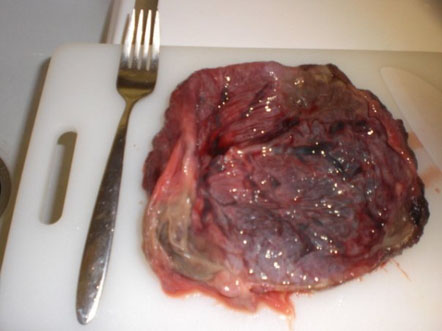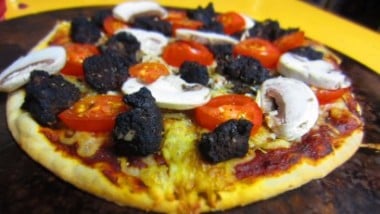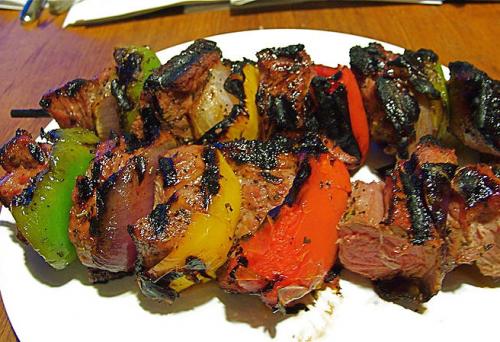Ladies, many young soon-to-be mothers in Freehold have asked if it is indeed safe to eat the placenta after giving birth since that horrifying incident with Naomi Portway. Many women have been understandably frightened by the whole affair, but Mr. Etheldreda has a cousin who is a True Christian™ doula, and she assures me that this is indeed a very safe practice. Furthermore, this practice has a long history in various cultures. Granted, they are all heathen cultures, pagan and dastardly, but it just goes to show you how safe it is that even the LORD's enemies are not smitten by eating their own placenta.
Jesus tells us, "I am the Bread of Life" (John 6:35). This is but one of the seven "I Am" statements of Jesus. Every time Jesus exclaims, "I Am," He expresses His salvific relationship toward the world. Calling Himself "Bread," Jesus equates Himself with a staple food, a basic dietary item, something we must consume for life. A person can survive a long time on only bread and water. Bread is such a basic food item that it becomes synonymous for food in general. We even use the phrase "breaking bread together" to indicate sharing a meal with someone. When the Jews were wandering in the desert for 40 years, God rained down "bread from heaven" to sustain the nation (Exodus 16:4). No other food was necessary.
This is the backdrop for the scene described in John 6. The Disciples would have immediately thought about Moses when Jesus made this statement. After some time of preaching, the question is raised as to how to feed the crowd. Philip illustrates the typical Jewish lack of faith when he said they don’t have enough money to give each of them the smallest morsel of food. Finally, Andrew brings to Jesus a boy who had five small loaves of bread and two fish. Of course we all remember how Jesus miraculously fed the crowd. Later Jesus tells them, "I am the bread of life; he who comes to Me will not hunger, and he who believes in Me will never thirst."
The LORD clearly draws a connection between the Saving Bread in the desert, and the Saving Bread of Jesus.
Let us now look inside to the womb. For 40 years the Jews wandered in the desert, dependent upon the LORD for sustenance. For 40 weeks a baby wanders, as it were, in an existence dependent upon their mother for sustenance. Just as God fed the Jews with manna, or "daily bread," God feeds the infant with manna, or placenta. Just as bread is staple for food, and Jesus is staple Salvation, placenta is staple for babies.
Coincidence? I think not.
Are we no smarter than the ignorant Jews, to throw away what the LORD has given the most precious of all humanity - the preborn babe? Are we no different than to stick our noses up in the air and declare this is not acceptable (Numbers 11:4–6)? Are we going to ignore that God has provided the placenta with such rich nutrients as iron, vitamin B12, oxytocin, prolactin, prostaglandins and endorphins? Are we going to tell the LORD we know better than He (Isaiah 10:15)? Have we become so dependent upon modern science that we forget our Creator made everything for us (Genesis 1:29-30)? Will we really discard this matronly bread of life in favor of some big pharma vitamins? Do we dare tell the LORD what He provides is naught but garbage?
Don't take my word for it. Google it yourself. Many decent and good Christian women eat the placenta after giving birth, and in doing so, honor the LORD by lovingly consuming this fetal "bread of life."
So in keeping with the spirit of honoring God, I thought we could share our recipes for cooking and storing the placenta, after the little baby is finished with it.
Placenta Lasagne:
Use your favorite Lasagne recipe and substitute this mixture for one layer of cheese. In 2 tbl. olive oil, quickly saute meat of 3/4 placenta, ground or minced; plus 2 sliced cloves of garlic, 1/2 tsp. oregano, 1/2 diced onion & 2 tbl. tomato paste, or 1 whole tomato.
Placenta Stew:
Meat of 3/4 placenta in bite size chunks, 1 potato (cubed), 1/4 cup fresh parsley, 2 carrots, 3 ribs celery, 1 zucchini, 1 large tomato, 1 small onion. Dredge meat in 1 tbl. flour mixed with 1 tsp. salt, 1/2 tsp. paprika, pinch of cloves, pinch of pepper, 6-8 crushed coriander seeds. Saute meat in 2 tbl. oil, then add vegetables (cut up) and 4-5 cups of water. Bring to full boil, then simmer for 1 hour.
Placenta Pizza:
Grind placenta. Saute in 2 tbl. olive oil with 4 garlic cloves, then add 1/4 tsp. fennel, 1/4 tsp. pepper, 1/4 tsp. paprika, 1/4 tsp. salt, 1/2 tsp. oregano, 1/4 tsp. thyme, and 1/4 cup of wine. Allow to stand for 30 minutes, then use with your favorite home made pizza recipe. It's a fine placenta sausage topping.
Placenta Spaghetti:
Cut meat of 3/4 placenta into bite size pieces, then brown quickly in 1 tbl. butter plus 1 tbl. oil. Then add 1 large can tomato puree, 2 cans crushed pear tomatoes, 1 onion, 2 cloves of garlic, 1 tbl. molasses, 1 bay leaf, 1 tbl. rosemary, 1 tsp. ea. of salt, honey, oregano, basil, and fennel. Simmer 1 1/2 hours.

You can also dry the placenta out and make supplements for later use.

And something the children enjoy, a special teddy bear lovingly made from the remains of the placental walls.

Please feel free to share your own favorite recipes.

A Biblical Look
Jesus tells us, "I am the Bread of Life" (John 6:35). This is but one of the seven "I Am" statements of Jesus. Every time Jesus exclaims, "I Am," He expresses His salvific relationship toward the world. Calling Himself "Bread," Jesus equates Himself with a staple food, a basic dietary item, something we must consume for life. A person can survive a long time on only bread and water. Bread is such a basic food item that it becomes synonymous for food in general. We even use the phrase "breaking bread together" to indicate sharing a meal with someone. When the Jews were wandering in the desert for 40 years, God rained down "bread from heaven" to sustain the nation (Exodus 16:4). No other food was necessary.
This is the backdrop for the scene described in John 6. The Disciples would have immediately thought about Moses when Jesus made this statement. After some time of preaching, the question is raised as to how to feed the crowd. Philip illustrates the typical Jewish lack of faith when he said they don’t have enough money to give each of them the smallest morsel of food. Finally, Andrew brings to Jesus a boy who had five small loaves of bread and two fish. Of course we all remember how Jesus miraculously fed the crowd. Later Jesus tells them, "I am the bread of life; he who comes to Me will not hunger, and he who believes in Me will never thirst."
The LORD clearly draws a connection between the Saving Bread in the desert, and the Saving Bread of Jesus.
What This Means For Us Today
Let us now look inside to the womb. For 40 years the Jews wandered in the desert, dependent upon the LORD for sustenance. For 40 weeks a baby wanders, as it were, in an existence dependent upon their mother for sustenance. Just as God fed the Jews with manna, or "daily bread," God feeds the infant with manna, or placenta. Just as bread is staple for food, and Jesus is staple Salvation, placenta is staple for babies.
Coincidence? I think not.
Are we no smarter than the ignorant Jews, to throw away what the LORD has given the most precious of all humanity - the preborn babe? Are we no different than to stick our noses up in the air and declare this is not acceptable (Numbers 11:4–6)? Are we going to ignore that God has provided the placenta with such rich nutrients as iron, vitamin B12, oxytocin, prolactin, prostaglandins and endorphins? Are we going to tell the LORD we know better than He (Isaiah 10:15)? Have we become so dependent upon modern science that we forget our Creator made everything for us (Genesis 1:29-30)? Will we really discard this matronly bread of life in favor of some big pharma vitamins? Do we dare tell the LORD what He provides is naught but garbage?
Don't take my word for it. Google it yourself. Many decent and good Christian women eat the placenta after giving birth, and in doing so, honor the LORD by lovingly consuming this fetal "bread of life."
So in keeping with the spirit of honoring God, I thought we could share our recipes for cooking and storing the placenta, after the little baby is finished with it.
Placenta Lasagne:
Use your favorite Lasagne recipe and substitute this mixture for one layer of cheese. In 2 tbl. olive oil, quickly saute meat of 3/4 placenta, ground or minced; plus 2 sliced cloves of garlic, 1/2 tsp. oregano, 1/2 diced onion & 2 tbl. tomato paste, or 1 whole tomato.
Placenta Stew:
Meat of 3/4 placenta in bite size chunks, 1 potato (cubed), 1/4 cup fresh parsley, 2 carrots, 3 ribs celery, 1 zucchini, 1 large tomato, 1 small onion. Dredge meat in 1 tbl. flour mixed with 1 tsp. salt, 1/2 tsp. paprika, pinch of cloves, pinch of pepper, 6-8 crushed coriander seeds. Saute meat in 2 tbl. oil, then add vegetables (cut up) and 4-5 cups of water. Bring to full boil, then simmer for 1 hour.
Placenta Pizza:
Grind placenta. Saute in 2 tbl. olive oil with 4 garlic cloves, then add 1/4 tsp. fennel, 1/4 tsp. pepper, 1/4 tsp. paprika, 1/4 tsp. salt, 1/2 tsp. oregano, 1/4 tsp. thyme, and 1/4 cup of wine. Allow to stand for 30 minutes, then use with your favorite home made pizza recipe. It's a fine placenta sausage topping.
Placenta Spaghetti:
Cut meat of 3/4 placenta into bite size pieces, then brown quickly in 1 tbl. butter plus 1 tbl. oil. Then add 1 large can tomato puree, 2 cans crushed pear tomatoes, 1 onion, 2 cloves of garlic, 1 tbl. molasses, 1 bay leaf, 1 tbl. rosemary, 1 tsp. ea. of salt, honey, oregano, basil, and fennel. Simmer 1 1/2 hours.

You can also dry the placenta out and make supplements for later use.

And something the children enjoy, a special teddy bear lovingly made from the remains of the placental walls.

Please feel free to share your own favorite recipes.





 said:
said:





Comment